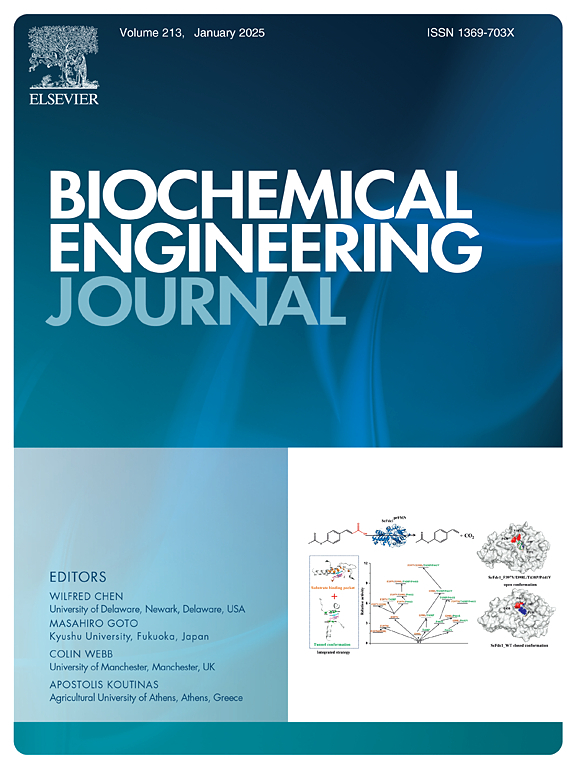PVA-SA 固定化复合菌株胎儿阿利舍瓦氏菌和深层外杆菌降解吡啶的生物强化机制
IF 3.7
3区 生物学
Q2 BIOTECHNOLOGY & APPLIED MICROBIOLOGY
引用次数: 0
摘要
煤化工废水(CCW)是一种难降解的有机废水,其特点是成分复杂、污染物浓度高,对全球水环境和公众健康构成严重威胁。本研究通过鉴定和应用两种高效的吡啶降解细菌菌株,重点研究 CCW 中臭名昭著的持久性有机污染物吡啶的降解问题:Alishewanella fetalis (Al-f3) 和 Exiguobacterium profundum (Ex-p)。这些菌株被固定在聚乙烯醇-海藻酸钠(PVA-SA)基质中,以研究它们在吡啶降解过程中的生物增强机制。研究结果表明,当初始吡啶浓度为 200 毫克/升时,Al-f3 和 Ex-p 菌株在 96 小时内的降解率分别为 95.94 % 和 97.83 %。将 Al-f3 和 Ex-p 菌株等比例混合并固定在 PVA/SA 珠子中,48 小时内降解率达到 81.06%,96 小时后降解率显著提高。这种提高主要归功于固定化后酶活性的显著提高(达到 17.13 μmol/mg- min),以及细胞外蛋白质和多糖分泌量的增加,48 小时内测得的分泌量分别为 3.47 mg/L 和 1.03 mg/L。值得注意的是,在固定化混合培养系统中,72 小时内总有机碳(TOC)降至仅 0.03 毫克/升,去除率达 92.31%。这些结果不仅证明了固定化混合菌株在降解吡啶方面的生物增效作用,还为生物降解 CCW 中的其他有机污染物提供了新的解决方案,从而提高了此类废水的处理效率。由于 PVA/SA 固定化基质具有较大的比表面积和成本效益,因此在处理 CCW 的生物降解过程中可作为高效的生物载体。这项研究为难降解工业废水的生物处理提供了创新的策略和方法。本文章由计算机程序翻译,如有差异,请以英文原文为准。
Bioenhancement mechanism of PVA-SA immobilized composite strains Alishewanella fetalis and Exiguobacterium profundum in pyridine degradation
Coal chemical wastewater (CCW) represents a type of recalcitrant organic wastewater characterized by its intricate composition and high concentration of pollutants, posing a severe threat to global aquatic environments and public health. This study focuses on the degradation of pyridine, a notoriously persistent organic pollutant in CCW, through the identification and application of two highly efficient pyridine-degrading bacterial strains: Alishewanella fetalis (Al-f3) and Exiguobacterium profundum (Ex-p). These strains were immobilized using a polyvinyl alcohol-sodium alginate (PVA-SA) matrix to investigate their bioaugmentation mechanisms in the pyridine degradation process. The findings indicate that strains Al-f3 and Ex-p achieved degradation rates of 95.94 % and 97.83 %, respectively, for an initial pyridine concentration of 200 mg/L at 96 hours. When strains Al-f3 and Ex-p were mixed in equal proportions and immobilized within PVA/SA beads, a degradation rate of 81.06 % was reached within 48 hours, with the efficiency increasing significantly by 96 hours. This enhancement is attributed primarily to the marked increase in enzymatic activity post-immobilization, achieving 17.13 μmol/mg·min, and the elevated secretion of extracellular proteins and polysaccharides, measured at 3.47 mg/L and 1.03 mg/L respectively within 48 hours. Notably, in the immobilized mixed culture system, the total organic carbon (TOC) was reduced to a mere 0.03 mg/L within 72 hours, with a removal rate of 92.31 %. These outcomes not only demonstrate the bioaugmentation role of the immobilized mixed strains in degrading pyridine but also offer novel solutions for the biodegradation of other organic contaminants in CCW, thereby enhancing the treatment efficiency of such wastewater. Given their large specific surface area and cost-effectiveness, PVA/SA immobilization matrices serve as efficient biocarriers in the biodegradation processes for treating CCW. This research provides innovative strategies and methods for the biotreatment of recalcitrant industrial wastewater.
求助全文
通过发布文献求助,成功后即可免费获取论文全文。
去求助
来源期刊

Biochemical Engineering Journal
工程技术-工程:化工
CiteScore
7.10
自引率
5.10%
发文量
380
审稿时长
34 days
期刊介绍:
The Biochemical Engineering Journal aims to promote progress in the crucial chemical engineering aspects of the development of biological processes associated with everything from raw materials preparation to product recovery relevant to industries as diverse as medical/healthcare, industrial biotechnology, and environmental biotechnology.
The Journal welcomes full length original research papers, short communications, and review papers* in the following research fields:
Biocatalysis (enzyme or microbial) and biotransformations, including immobilized biocatalyst preparation and kinetics
Biosensors and Biodevices including biofabrication and novel fuel cell development
Bioseparations including scale-up and protein refolding/renaturation
Environmental Bioengineering including bioconversion, bioremediation, and microbial fuel cells
Bioreactor Systems including characterization, optimization and scale-up
Bioresources and Biorefinery Engineering including biomass conversion, biofuels, bioenergy, and optimization
Industrial Biotechnology including specialty chemicals, platform chemicals and neutraceuticals
Biomaterials and Tissue Engineering including bioartificial organs, cell encapsulation, and controlled release
Cell Culture Engineering (plant, animal or insect cells) including viral vectors, monoclonal antibodies, recombinant proteins, vaccines, and secondary metabolites
Cell Therapies and Stem Cells including pluripotent, mesenchymal and hematopoietic stem cells; immunotherapies; tissue-specific differentiation; and cryopreservation
Metabolic Engineering, Systems and Synthetic Biology including OMICS, bioinformatics, in silico biology, and metabolic flux analysis
Protein Engineering including enzyme engineering and directed evolution.
 求助内容:
求助内容: 应助结果提醒方式:
应助结果提醒方式:


